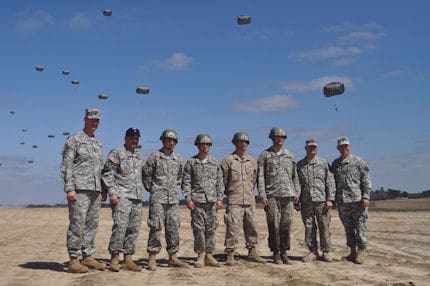The T-11 parachute, also referred to as the Advanced Tactical Parachute System has already begun to replace the venerable T-10 with operational units. As Fort Benning’s Basic Airborne Course trains new parachutists, they too have have begun the transition to the new system. Students will continue to train with both since the transition to the T-11 will take about three years, but the class graduating last week was the first to have jumped the new parachute.
T-11 Ft. Bragg NC – LTG Helmick Jump from PEO Soldier on Vimeo.
This PEO-Soldier video of a recent jump by the 18th Corps Staff gives you a good idea of the characteristics of the parachute.
One of the first things you will notice about the new canopy is its shape. Rather than the traditional conical shape of the T-10 the T-11 boasts 28% more surface area and assumes a somewhat square shape due to a modified version of a cross/cruciform. This results in a slower rate of descent and a softer landing (19 fps vice 24 fps). Additionally, the T-11 replaces not only the round canopy but the harness as well which is designed to displace opening shock forces of the reserve parachute equally along the long axis of the jumper’s body. While the T-10 relies on the Modified Improved Reserve Parachute System (MIRPS) which includes a standard T-10 reserve parachute canopy assembly integrated with a commercial deployment assistance device to throw the canopy out away from the jumper, the new T-11R is based on the British Low Level Parachute (LLP) aero-conical design that includes apex scoop pockets at the top of the reserve canopy and skirt assist lines at the system’s hem to promote fast opening of the reserve during low-speed malfunctions. Unlike MIRPS, the T-11R reserve uses an omni-directional, center-pull deployment system.


